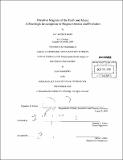Primitive magmas of the Earth and Moon : a petrologic investigation of magma genesis and evolution
Author(s)
Barr, Jay Arthur
DownloadFull printable version (11.70Mb)
Other Contributors
Massachusetts Institute of Technology. Dept. of Earth, Atmospheric, and Planetary Sciences.
Advisor
Timothy L. Grove.
Terms of use
Metadata
Show full item recordAbstract
Field studies, major and trace element geochemistry, isotopes, petrography, phase equilibrium experiments and thermodynamics are used investigate and understand primitive melts from the Earth and the Moon. Chapter 1 investigates spinifex orthopyroxene compositions from the komatiites of Commondale, South Africa, and uses phase equilibrium experiments to illustrate that the Commondale Komatiites were hydrous magmas when they were emplaced. Hydrous komatiites provide evidence for the existence of subduction zone volcanism during the Archean, and decreases the temperature required to explain komatiites volcanism, which is the major physical evidence used to determine the mantle potential temperature of the Archean. Chapter 2 uses phase equilibrium experiments investigate the origin of the Apollo 15 green glasses from the Moon. Garnet-lherzolite saturated experiments are used to calibrate a melting algorithm used to estimate the chemical compositions of melts of a primordial lunar mantle. Mixing models are used to reproduce the Apollo 15 green glass compositions. These models are consistent with primordial melts assimilating late stage lunar magma ocean cumulates to produce the green glasses. This provides evidence for the magma overturn hypothesis, as well as evidence that the lunar magma ocean may not have been whole moon. Chapter 3 uses phenocryst petrology, Os-isotopes, major and trace element geochemistry and petrography to argue for the formation of primitive magnesian andesites of Mt. Shasta and Mt. Lassen as primary mantle melts. Recent proposals that primitive magnesian andesites form by mixing dacites with subvolcanic peridotite are disproven. Samples of these lavas from newly discovered localities provide clear evidence for a mantle origin for these melts. Understanding the primitive melts present in the Cascade volcanoes will yield greater insight into the mantle processes involved in the plumbing of the sub-arc mantle. Chapter 4 develops a ternary regular solution model for Au-Pd-Fe alloys and uses this with Fe-exchange experiments to model the dependence of alloy composition on the oxygen fugacity. Au-Pd alloy capsules are essential to hydrous phase equilibrium studies at high-pressure and high-temperature, and the use of this model allows for the quantification of the oxygen fugacity of these experiments without compromising sample volume.
Description
Thesis (Ph. D.)--Massachusetts Institute of Technology, Dept. of Earth, Atmospheric, and Planetary Sciences, 2010. "September 2010." Cataloged from PDF version of thesis. Includes bibliographical references.
Date issued
2010Department
Massachusetts Institute of Technology. Department of Earth, Atmospheric, and Planetary SciencesPublisher
Massachusetts Institute of Technology
Keywords
Earth, Atmospheric, and Planetary Sciences.